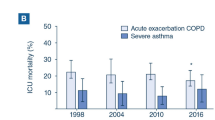ABSTRACT
Purpose
To quantify distribution of albuterol aerosol generated by a pneumatic nebulizer within the nose and lungs of a model of a 9-month-old child (SAINT) and aerosol loss to the environment, during simulated breathing at increasing tidal volumes (TVs).
Methods
99mtechnetium-labeled albuterol aerosol was generated by an IPI nebulizer with face-mask. Deposition was quantified as a percentage of emitted dose using gamma scintigraphy.
Results
Lung deposition was similar for all TVs, averaging 7.17 ± 0.01%, 9.34 ± 0.01% and 9.41 ± 0.02% at 50, 100 and 200 mL TV, respectively. In contrast, nose deposition increased significantly with TV, averaging 4.40 ± 0.02%, 11.39 ± 0.02% and 22.12 ± 0.02% at 50 mL, 100 mL and 200 mL TV, respectively (all p < 0.0167). Aerosol loss to the environment was significantly lower at 200 mL TV (53.81 ± 0.04%), compared to 50 mL (71.99 ± 0.02%) (p < 0.0167).
Conclusions
Our results suggest that nasal deposition of albuterol aerosol generated by a pneumatic nebulizer in 9-month-old infants may be significantly affected by changes in TV, ranging between 50 to 200 mL, whereas total lung deposition may not be affected. These results also predict that environmental losses would be highest when administering to a child breathing at 50 mL TV. These data should be useful to companies who are working to improve aerosol delivery systems to treat infants.






Similar content being viewed by others
REFERENCES
Berg E, Madsen J, Bisgaard H. In vitro performance of three combinations of spacers and pressurized metered dose inhalers for treatment in children. Eur Respir J. 1998;12:472–6.
Everard ML, Clark AR, Milner AD. Drug delivery from holding chambers with attached facemask. Arch Dis Child. 1992;67:580–5.
Finlay WH, Zuberbuhler P. In vitro comparison of beclomethasone and salbutamol metered dose inhaler aerosols inhaled during pediatric tidal breathing from four valved holding chambers. Chest. 1998;114:1676–80.
Mitchell JP, Nagel MW. In vitro performance testing of three small volume-holding chambers under conditions that correspond with use by infants and small children. J Aerosol Med. 1997;10:341–9.
Barry PW, O’Callaghan C. The output of budesonide from spacer devices assessed under simulated breathing conditions. J Allergy Clin Immunol. 1999;104:1205–10.
Janssens HM, Van der Wiel EC, Verbraak AFM, de Jongste JC, Merkus PJFM, Tiddens HAWM. Aerosol therapy and the fighting toddler: Is administration during sleep an alternative? J Aerosol Med. 2003;16:395–400.
Bisgaard H. Patient-related factors in nebulized drug delivery to children. Eur Respir Rev. 1997;7:376–7.
Janssens HM, de Jongste JC, Fokkens WJ, Robben SGF, Wouters K, Tiddens HAWM. The Sophia Anatomical Infant Nose-Throat (SAINT) Model: A valuable tool to study aerosol deposition in infants. J Aerosol Med. 2001;14:433–41.
Minocchieri S, Burren JM, Bachmann MA, Stern G, Wildhaber J, Buob S, et al. Development of the premature infant nose throat-model (PrINT-Model)- an upper airway replica of a premature neonate for the study of aerosol delivery. Pediatr Res. 2008;64:141–6.
Foo MY. Y-S. Cheng, W-C. Su and M.D. Donovan. The influence of spray properties on intranasal deposition. J Aerosol Med. 2007;20:495–508.
Janssens HM, Krijgsman A, Verbraak TFM, Hop WCJ, de Jongste JC, Tiddens HAWM. Determining factors of aerosol deposition for four pMDI-spacer combinations in an infant upper airway model. J Aerosol Med. 2004;17:51–61.
Laube BL, Edwards AM, Dalby RN, Creticos PS, Norman PS. The efficacy of slow versus faster inhalation of cromolyn sodium in protecting against allergen challenge in patients with asthma. J Allergy Clin Immunol. 1998;101:475–83.
Laube BL, Benedict GW, Dobs AS. Time to peak insulin level, relative bioavailability and effect of site of deposition of nebulized insulin in patients with non-insulin dependent diabetes mellitus. J Aerosol Med. 1998;11:153–73.
Stick S. Measurements during tidal breathing. In: Sly P, Tepper R, Morgan W, editors. Infant respiratory function testing. New York: Wiley-Liss; 1996. p. 134.
Chua HL, Collis GG, Newbury AM, Chan K, Bower GD, Sly PD, et al. The influence of age on aerosol deposition in children with cystic fibrosis. Eur Respir J. 1994;7:2185–91.
Wildhaber JH, Dore ND, Wilson JM, Devadason SG, Le Souef PN. Inhalation therapy in asthma: nebulizer or pressurized metered-deposition inhaler with holding chamber? In vivo comparison of lung deposition in children. J Pediatr. 1999;135:28–33.
ACKNOWLEDGEMENTS
The authors wish to thank Robert Sievers, Ph.D. and his colleagues at Aktiv-Dry, LLC for their support of this study and Becton Dickinson for providing the PARI Breath Simulator used in these experiments. The authors also wish to thank Drs. H. M. Janssens and H. Tiddens of Erasmus Medical Center Rotterdam/Sophia Children’s Hospital (Rotterdam, The Netherlands), Dr. Johannes Wildhaber of the Department of Pediatrics, Kantonsspital (Fribourg, France) and Professor Lars Borgstroem of AstraZeneca Research and Development (Lund, Sweden) for providing the copies of the SAINT model used in these experiments.
Author information
Authors and Affiliations
Corresponding author
Rights and permissions
About this article
Cite this article
Laube, B.L., Sharpless, G., Shermer, C. et al. Deposition of Albuterol Aerosol Generated by Pneumatic Nebulizer in the Sophia Anatomical Infant Nose-Throat (SAINT) Model. Pharm Res 27, 1722–1729 (2010). https://doi.org/10.1007/s11095-010-0171-1
Received:
Accepted:
Published:
Issue Date:
DOI: https://doi.org/10.1007/s11095-010-0171-1




